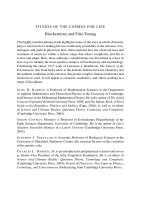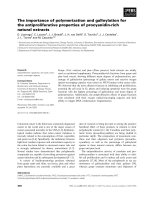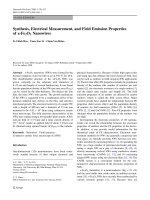Synthesis and fine tuning the emission properties of new amphiphilic conjugated polymers
Bạn đang xem bản rút gọn của tài liệu. Xem và tải ngay bản đầy đủ của tài liệu tại đây (2.92 MB, 221 trang )
SYNTHESIS AND FINE-TUNING THE EMISSION
PROPERTIES OF NEW AMPHIPHILIC CONJUGATED
POLYMERS
CHINNAPPAN BASKAR
NATIONAL UNIVERSITY OF SINGAPORE
2004
SYNTHESIS AND FINE-TUNING THE EMISSION
PROPERTIES OF NEW AMPHIPHILIC CONJUGATED
POLYMERS
CHINNAPPAN BASKAR
(M.Sc., IIT MADRAS)
A THESIS SUBMITTED
FOR THE DEGREE OF DOCTOR OF PHILOSOPHY
DEPARTMENT OF CHEMISTRY
NATIONAL UNIVERSITY OF SINGAPORE
2004
i
Dedicated to my beloved parents
ii
Dedicated to my beloved teachers and inspirational minds
“If I have been able to see further, it was only because I stood on the shoulders of giants.”
- Sir Isaac Newton (1642-1727)
iii
Acknowledgements
Life on Earth is a journey, starts as well as ends with Almighty, like cyclic reactions.
During this journey, we are blessed with invaluable teachers and well wishers. It is very
difficult to forget important events, ups and downs, achievements, excellent
collaborators, contributors, great inspirational minds, and the land of harvest. At the end
of my journey to PhD, it is a great pleasure to acknowledge people, who have supported
my growth.
First and above all I would like to thank Dr. Suresh Valiyaveettil for his invaluable
guidance throughout my PhD research work.
I thank Prof Lai Yee Hing and Prof Leslie Harrison for their interest in serving on my
advisory committee. I would like to thank Prof Jagadese J. Vittal, Prof Chuah Gaik
Khuan, Dr. John Yip and Dr. Yang Daiwen for their support as my thesis committee.
My heartfelt thanks to Prof Hardy Chan (Vice Dean, Faculty of Science), Prof Andrew
Wee (Vice Dean), Prof Xu Guo Qin (Vice Dean), Prof Tan Eng Chye (Dean), Prof Lai
Choy Heng and Prof Andy Hor for their support and encouragement during my
contributions in Science Graduate Committee (SGC), Graduate Students Society (GSS),
and Chemistry Graduate Club (CGC). My special thanks to Prof Hian Kee Lee (Head,
Chemistry), Prof Ng Siu Choon (Deputy Head) and Prof Leung Pak Hing (Deputy Head).
iv
My sincere gratitude to Prof Seeram Ramakrishna (Dean, Faculty of Engineering), Prof
Senthil Kumar (Assitant Dean, FoE), Prof Goh Suat Hong (Chemistry), Prof Ji Wei
(Physics), Prof Perera Conrad (Chemistry), Prof B. V. R. Chowdari (Physics), Prof G. V.
Subba Rao (Physics), Prof K. Swaminathan (DBS) and Dr. Ignacio Segarra (S*Bio).
During this period of my doctoral research program, I was certainly blessed to meet many
great minds including Prof Roald Hoffmann (1981 Nobel Laureate in Chemistry), Prof
Carl Djerassi (Stanford University, USA), Prof C. N. R. Rao (President, JNCAR,
Bangalore), Prof Alan Heeger (2000 Nobel Laureate in Chemistry), Prof Hideki
Shirakawa (2000 Nobel Laureate in Chemistry), Prof John C. Warner (University of
Massachusetts Boston, USA), Dr. Paul Anastas (Director, Green Chemistry Institute,
American Chemical Society, USA), Dr. Dennis Hjeresen (Former Director, Green
Chemistry Institute, American Chemical Society, USA) and Dr. Mary Kirchhoff
(Assistant Director, Green Chemistry Institute, American Chemical Society, USA). My
sincerest thanks to all of them for their suggestion, motivation and inspiration.
My thanks are also to Prof K. V. Ramanujachary (Rowan University, USA), Prof R. K.
Sharma (University of Delhi, India), Prof B. Viswanathan (IIT Madras), and Prof G.
Sundararajan (IIT Madras) for their informal discussion and encouragements during their
journey in Singapore.
I would like to thank Prof Bengt Nordén (Member, The Royal Swedish Academy of
Sciences, Chairman, The Nobel Committee for Chemistry in 2000, Nobel Foundation),
v
Ms. Birgitta Sandell (Assistant, The Royal Swedish Academy of Sciences) and Ms. Elin
Stenbom (Assistant, The Royal Swedish Academy of Sciences) for their support to
include the year 2000 Nobel Prize Presentation in Chemistry in my thesis and regular
Nobel Posters.
My sincerest thanks also go to Prof M. S. Subramanian (My graduate mentor, IIT
Madras) and Prof Xavier Machado (My undergraduate teacher, St. Joseph’s College,
Trichy, India) for their invaluable suggestion, motivation and encouragement.
I want to thank many people without whom I would not have been able to complete the
work presented in this thesis. I want to warmly thank all the support staff of the chemistry
department in the main office, NMR, MS, Elemental Analysis, X-ray crystallography
facilities, chemical stores, Honors lab, analytical lab, organic lab, and in the glassblowing
shops. I would like to acknowledge the Department of Chemistry for their hospitality and
encouragement on my graduate study.
I wish to thank all of my past and present colleagues of the Dr. Suresh Group.
I extend my special thanks to my friends especially Felix Lawrence, Lakshmanan,
Skanth, Karen, Nacha, Hendry Elim, Kangueane, Arockiam and Peter, classmates and
housemates.
vi
I would like to specially thank my parents, brothers (Doss and Julian), and my uncle
Sebastian for all the moral and financial support selflessly provided throughout my
career. I would like to thank my sister, Ammu Margaret, who stayed up with me over the
phone when I was stressed out, encouraged me when I was down, prayed for me when I
didn’t think to pray for myself and believed in me when I didn’t believe in myself.
Last but not least, I would like to thank God. “So, whatever you eat or drink, or whatever
you do, do everything for the glory of God.” – I Corinthians 10:31 (Holy Bible)
CHInNaPPaN BaSKAr
May 22, 2004 Saturday
vii
Table of Contents
Dedication
Acknowledgements
Table of Contents
Summary
List of Monomers and Polymers Synthesized in this Thesis
List of Figures
List of Schemes
List of Tables
Glossary of Abbreviations and Symbols
Opening Quotations
i
iii
vii
xii
xvi
xxi
xxiii
xxiv
xxv
xxxii
Chapter 1 Introduction: The Art and Science of
Conjugated Polymers
1
1.1
1.2
1.3
1.4
1.5
Prologue
Genesis of Conjugated Polymers
A Case History of Poly(p-phenylene)s PPPs
Pyridine incorporated conjugated polymers
Bipyridine incorporated conjugated polymers
2
6
13
23
28
viii
1.6
1.7
1.8
Poly(m-phenylene)s (PMPs)
Aim of the project
References
33
37
38
Chapter 2 Amphiphilic Poly(p-phenylene)s
75
2.1
2.2
2.3
2.4
2.5
2.6
Introduction
Synthesis of polymers
Characterization of polymers
Optical and ionochromic properties of polymers
Conclusions
References
76
77
79
81
89
90
Chapter 3 Pyridine Incorporated Amphiphilic
Conjugated Polymers
94
3.1
3.2
3.3
3.4
3.4.1
Introduction
Synthesis of polymers
Characterization of polymers
Optical Properties
Influence of hydroxyl groups
95
98
101
103
103
ix
3.5
3.6
3.4.2
3.4.3
3.4.4
3.4.5
3.4.6
Comparison of properties of polymers
Solvatochromic behavior of polymers
Effect of protonation and deprotonation of polymers
Influence of base
Metal complexation of polymers
Conclusions
References
107
107
110
113
115
117
118
Chapter 4 Bipyridine Incorporated Conjugated
Polymers
125
4.1
4.2
4.3
4.4
4.5
4.6
4.7
4.8
Introduction
Synthesis of polymers
Characterization of polymers
Optical properties of polymers
Solvatochromic behavior of polymers
Ionochromic effects of polymers
Conclusions
References
126
129
132
133
134
134
137
138
x
Chapter 5 Experimental Section
142
5.1
5.2
5.3
5.4
5.5
5.3.1
5.3.2
5.3.3
5.3.4
5.3.5
5.3.6
5.3.7
5.4.1
5.4.2
5.4.3
5.4.4
5.4.5
5.4.6
Materials
Measurements
Synthesis of polymers 201a-c
2,5-Dibromohydroquinone (203)
2,5-Dibromo-4-dodecyloxy phenol (204a)
2,5-Dibromo-1-benzyloxy-4-dodecyloxy benzene (205a)
1-Benzyloxy-4-dodecyloxyphenyl-2,5-bisboronic acid
(206a)
1-Benzyloxy-4-dodecyloxy phenyl-2,5-bis(trimethylene
boronate) (207a)
Poly(1-benzyloxy-4-dodecyloxy-p-phenylene) (208a)
Poly(1-hydroxy-4-dodecyloxy-p-phenylene) (201a)
Synthesis of polymers 301-306
2,5-Dibromo-1, 4-dibenzyloxy benzene (312)
1,4-Dibenzyloxy-2,5-bisboronic acid (313)
Synthesis of Polymer 304
Synthesis of Polymer 301
Synthesis of Polymer 305
Synthesis of Polymer 302
References
143
143
145
145
145
147
148
150
151
152
153
153
153
154
155
156
156
157
xi
Chapter 6 Conclusions and Suggestions for the
future work
158
6.1
6.2
6.2.1
6.2.2
Conclusions
Suggestions for the future work
Applications of new amphiphilic conjugated polymers
Design of new polymer structures: Evolution of
hydroxylated polyphenylenes (HPPs)
159
160
160
160
List of Publications
162
Recent Publications
Unpublished Papers
International Conference Papers
International Conference Presentations
National Publications
National Presentations
163
163
164
166
168
169
Appendix
171
Absorption maxima of non-hydroxyl-containing
conjugated polymers
TG curves of 301-403
172
178
xii
Summary
SYNTHESIS AND FINE-TUNING THE EMISSION PROPERTIES OF NEW
AMPHIPHILIC CONJUGATED POLYMERS
By
Chinnappan Baskar
May 2004
Since the discovery of conducting polymers in the late 1970’s, research efforts
were focused on synthesis and characterization of novel polymers with π-conjugated
backbone due to their interesting optical, electrochemical and conducting properties and
possible applications in electroluminescent devices, nonlinear optical materials, lasing
materials, solar cells, fuel cells, batteries, photoconductors, field effect transistors,
chemical and biosensors, nanoscience and nanotechnology, and biomedical applications.
A variety of conjugated polymers have been investigated and reported in literature.
Among these polymers, poly(p-phenylene) (PPP) and its derivatives have found
considerable interest in blue light-emitting diodes over the last ten years.
The present work reports on syntheses and fine-tuning the emission properties of
a series of new amphiphilic poly(p-phenylene)s PPPs containing free hydroxyl groups
and hydrogen bond acceptor groups such as nitrogen atoms on polymer back bone
capable of forming an inter/intra molecular hydrogen bonding. This allows us to
planarize the neighboring aromatic rings on the polymer backbone and thereby extending
the π-conjugation of the polymer backbone. These hydroxyl and nitrogen sites also act as
potential binding sites for complexation with metal ions.
xiii
Three types of new amphiphilic conjugated polymers were prepared using Suzuki
coupling reaction in good yields. These polymers are: amphiphilic PPPs (201a-c),
pyridine incorporated PPP (2,5-linkage) and poly(m-phenylene) PMP (2,6-linkage) (301-
306), and bipyridine incorporated polyphenylene (both 2,5 and 2,6-linkage) (401-403).
Their structures were confirmed by Nuclear Magnetic Resonance (NMR), infrared (IR),
and elemental analysis. All polymers showed good solubility in common organic solvents
such as chloroform, tetrahydrofuran (THF), dimethyl formamide (DMF), toluene, formic
acid (HCOOH) and trifluoroacetic acid (TFA). Thermogravimetric analysis (TGA)
results showed that they had good thermal stability in both nitrogen and air atmosphere.
The optical properties of these novel polymers were closely related to the
architectures of the backbone and studied using different solvents. Polymers with
pyridine and bipyridine were showed positive solvatochromic effect. The target polymers
exhibited different absorption/emission properties based on the nature and type of solvent
used. The ionochromic effect of polymers was investigated using various metal salts
added to the polymer solutions. The color of the polymers solution was changed from
light yellow to blue, green, or reddish brown depending on the type of metal ions added.
Polymers with pyridine and bipyridine were found to exhibit reversible and tunable
optical properties depending on metal complexation and protonation-deprotonation
process.
In conclusion, a novel series of optically tunable amphiphilic conjugated
polymers have been successfully synthesized and studied in detail. All the derived
polymers showed good solubility in common organic solvents. The emission color could
be tuned by introducing different linked polymer backbones and by using different
xiv
solvents and metal ions. The characterization of these polymers suggested that they were
promising candidates for application in polymeric light emitting diode (PLED), nonlinear
optical properties (NLO), sensors for metal ions, catalytic studies and other properties.
Style of thesis:
Chapter 1 focuses on the introduction and historical perspectives of conjugated
polymers, illustrated with numerous examples (up-to-date). This chapter is divided into
seven major parts: Prologue (with the year 2000 Nobel Prize Presentation in Chemistry),
classification of conjugated polymers, a case history of PPPs with the examples of PPP
and PPP related structures, pyridine incorporated conjugated polymers, bipyridine
incorporated conjugated polymers, PMPs, and aim of the project.
Chapter 2 is focused on a series of optically tunable amphiphilic conjugated
polymers, poly(2-hydroxy-5-alkoxy-p-phenylene) (201a-c) containing long alkyl chains
prepared by Suzuki polycondensation using 2,5-dibromo-1-benzyloxy-4-alkoxybenzene
and bis(boronic ester) monomers. Optical properties of all polymers were investigated in
THF at room temperature under neutral condition and emission maxima were observed in
the violet region (λ
emi
= 401- 403 nm). By the addition of stoichiometric amount of a base
(e.g. aqueous NaOH solution), absorption maxima shifted to the blue region (λ
emi
= 474 –
468 nm). Ionochromic effect of target polymers with transition metal ions such as Fe
3+
,
Cu
2+
, and Co
2+
was also reported. In the presence of metal ions, the optical properties of
polymers showed interesting tunability of emission maxima, ∆λ
max
(140 nm to 26 nm).
Chapter 3 is focused on three fluorescent amphiphilic π-conjugated polymers with
donor and acceptor groups prepared by Suzuki polycondensation method. The resulting
xv
polymers containing long alkyl chains showed good solubility in common organic
solvents such as chloroform, toluene, THF, DMF and formic acid. The absorption and
emission wavelength of the synthesized copolymers gave positive solvatochromism in
solvents of varying polarity. The polymers 301-303 dissolved in chloroform showed a
large stokes shift, presumably due to excited-state intramolecular proton transfer (ESIPT)
mechanism. The precursor polymers 304-306 exhibiting large stokes shift due to
intramolecular charge transfer (ICT). We also explored the ion responsive properties of
the target polymers with different metal ions such as Cu
2+
, Co
2+
, Ni
2+
, and Fe
3+
. Polymers
complexed with metal ions indicated large metal-to-ligand charge transfer (MLCT).
Chapter 4, three types of conjugated copolymers containing bipyridine and 1,4-
phenylene units in an alternative sequence (401-403) were prepared by Suzuki
polycondensation. The resulting polymers showed good solubility in common organic
solvents such as chloroform, toluene, THF and DMF. Optical properties of synthesized
copolymers were investigated using chloroform, THF and HCOOH. All the polymers
showed interesting optical properties and possessed sensitivity to various metal ions such
as Cu
2+
, Mn
2+
, and Fe
3+
. It was found that the absorption and emission maxima of the
polymers could easily be fine-tuned by varying solvents and metal ions.
Chapter 5 focuses on the experimental section of all polymers and compounds
synthesized in this work.
Chapter 6 focuses on conclusion and suggestions for the future work.
xvi
List of Monomers and Polymers Synthesized in this Thesis
Table 1. The polymers and main compounds prepared in this thesis
Chapter
No.
Main monomers (compounds)
Polymers
Chapter 2
xvii
Table 1. The polymers and main compounds prepared in this thesis (Continued)
Chapter
No.
Main monomers (compounds)
Polymers
Chapter
3
xviii
Table 1. The polymers and main compounds prepared in this thesis (Continued)
Chapter
No.
Main monomers (compounds)
Polymers
Chapter 3
xix
Table 1. The polymers and main compounds prepared in this thesis (Continued)
Chapter
No.
Main monomers (compounds)
Polymers
Chapter 4
xx
Table 1. The polymers and main compounds prepared in this thesis (Continued)
Chapter
No.
Main monomers (compounds)
Polymers
Chapter 4
xxi
List of Figures
Figure 1-1
Figure 1-2
Figure 1-3
Figure 1-4
Figure 1-5
Figure 1-6
Figure 2-1
Figure 2-2
Figure 2-3
Figure 2-4
The art and science of conjugated polymers
Examples of conjugated polymers, note the bond-
alternated structures
Examples of poly(p-phenylene)s (PPP)s
Examples of pyridine incorporated conjugated polymers
Examples of bipyridine incorporated conjugated polymers
Examples of poly(m-phenylene)s (PMPs)
Structures of amphiphilic poly(p-phenylenes) 201a-c
Absorbance and emission spectra of Polymer 201a
X-ray powder diffraction pattern of polymer 201a
Illustration of the polymer lattice indicating alkyl chain
packing and interchain hydrogen bonding or metal
complexation
1
8
14
24
28
34
77
82
84
86
xxii
List of Figures
Figure 3-1
Figure 3-2
Figure 3-3
Figure 3-4
Figure 3-5
Figure 3-6
Figure 3-7
Figure 4-1
Figure 4-2
Figure 6-1
Figure A 1-9
Molecular structures of target polymers 301-306
Absorbance and emission spectra of polymers 304 and 301
in chloroform
Excited-state intramolecular proton transfer (ESIPT) for
polymer 301
UV/Vis spectra of Protonation and Deprotonation of
polymers 301-303 with aqueous HCl and aqueous NaOH
in THF
Proton Transfer from the excited cation of polymer 301 to
a base B
UV/Vis spectra of polymers 301 and 303 without and with
aqueous NaOH in DMF
Emission spectra of polymers 301 and 303 without and
with aqueous NaOH in DMF
Molecular structure of the polymers 401-403
Absorbance and emission spectra of polymers 401 and 402
in THF
Evolution of hydroxylated polyphenylenes (HPP)s
TG curves of 301-403
97
104
106
111
112
113
114
128
133
161
178
xxiii
List of Schemes
Scheme 2-1
Scheme 3-1
Scheme 3-2
Scheme 4-1
Scheme 4-2
Synthesis of polymers 201a-c
Synthesis of polymers 301 and 302
Synthesis of polymer 303
Synthesis of polymers 401 and 402
Synthesis of polymer 403
78
99
100
130
131









